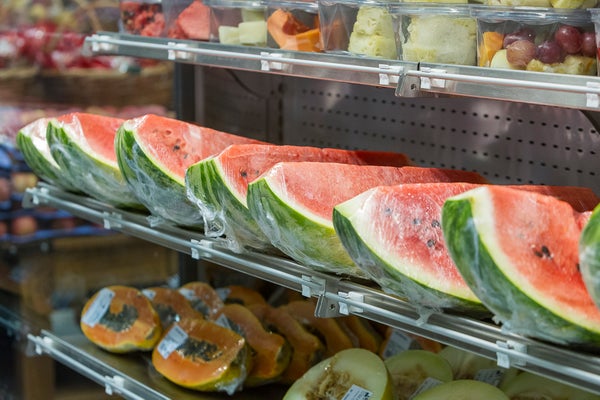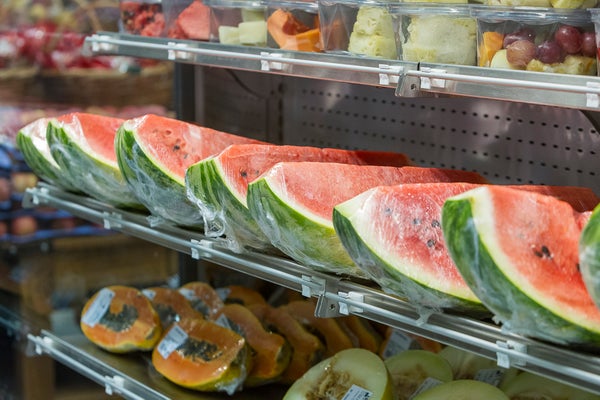61 Unexpected ‘Forever Chemicals’ Found in Food Packaging
A global study identified 61 PFAS chemicals in food packaging that are not authorized for use in such products

PFASs can be found in various food packaging, ranging from coated paper wrappers to plastic containers.
Erlon Silva – TRI Digital/Getty Images
Food packaging from around the world contains at least 68 “forever chemicals” that can seep into what we eat, a new study finds. And 61 of them are not even supposed to be used in such products. This kind of packaging may include coated paper wrappers, plastic containers and aluminum foil. Scientists behind the paper say it’s not clear why the latter chemicals, which are not on lists of those authorized for use in food containers, are in such packaging.
“It’s very hard to explain where they come from,” says the study’s senior author Birgit Geueke, senior scientific officer at the nonprofit Food Packaging Forum Foundation in Zurich. That’s especially concerning because her team was only able to find data on potential hazards for 57 percent of the chemicals the researchers found in food packaging.
The study, published on Tuesday in Environmental Science & Technology, focused on a class of chemicals called perfluoroalkyl and polyfluoroalkyl substances (PFASs). For decades, these substances have been used in a wide range of consumer products, from cookware to pesticides to cosmetics, because of their ability to repel water and grease.
On supporting science journalism
If you’re enjoying this article, consider supporting our award-winning journalism by subscribing. By purchasing a subscription you are helping to ensure the future of impactful stories about the discoveries and ideas shaping our world today.
PFASs are sometimes called “forever chemicals” because they don’t break down readily in the environment or in the body. That’s because their characteristic carbon-fluorine bond—part of what makes them so useful in the first place—is one of the strongest in nature. PFASs have been found in human blood and breast milk, drinking water, soil and other startling places around the world. In March 2023 the U.S. Environmental Protection Agency announced a drinking water standard for six PFAS compounds. Exposure to some of the most studied PFASs has been associated with cancer, reproductive problems and lessened responses to vaccines. “There’s an incredible body of scientific evidence linking these chemicals to health harms,” says David Andrews, a chemist and toxicologist at the Environmental Working Group, a nonprofit environmental advocacy organization, who was not involved with the new study.
The paper adds to recently growing concerns about the prevalence of PFASs—and about an overall dearth of knowledge as to what chemicals are found in many everyday products. “Food packaging may not be the only way we are exposed to PFAS, but food packaging could contribute” to these exposures, Geueke says.
She and her team found a mismatch between what they detected in actual products and a database of chemicals assembled by compiling information on PFAS that regulatory agencies (including the U.S. Food and Drug Administration) have authorized for use in food packaging, and PFAS that industrial manufacturers have listed for use in food packaging. About 140 PFASs are known to be used in food packaging, but only seven of the 68 chemicals in the study were on this list. Geueke says it’s unclear how or why the other 61 chemicals turned up. Andrews suggests that it’s possible that unknown impurities emerged during the manufacturing of the authorized chemicals or that the authorized PFASs degrade over time. This class of chemicals includes many long-chain molecules, and they can break into shorter chains that are simply different types of PFASs.
Some of the PFASs found in the study are known to have adverse health effects. One such chemical is perfluorooctanoic acid (PFOA), which was banned under the Stockholm Convention on Persistent Organic Pollutants in 2019. PFOA was found in the blood of nearly every person in a large study conducted in the U.S. by the Centers for Disease Control and Prevention. In animal studies, PFOA has caused developmental problems and liver injuries and has affected reproduction.
On February 28 the FDA announced that paper and paperboard food packaging coated with grease-proofing PFASs would no longer be sold in the U.S. Anderson says it’s likely paper packaging materials were targeted before metal or plastic because the FDA has studied them extensively. He cites a 2020 study by FDA researchers that found that a PFAS impurity found in fast-food packaging was potentially toxic. FDA-authorized PFASs can be used on other kinds of food packaging and in other items that contact food—such as nonstick cookware and gaskets used in food-processing equipment. The European Union’s European Chemicals Agency is evaluating proposed restrictions of PFASs in food packaging and other applications.
Chemical industry representatives have advocated for dealing with PFASs as individual chemicals. Scientific American reached out to the American Chemistry Council (ACC), a chemistry industry trade association, about this new study, but the organization did not reply before publication. On its dedicated PFAS webpage, ACC notes that “all PFAS are not the same. Each individual chemistry has its own unique properties and uses.”
Andrews and Geueke both say the presence of unknown PFASs in food packaging is good reason to regulate these chemicals as a single class—a position shared with many other scientific experts and environmental protection groups. There are more than 12,000 known PFASs, and scientists don’t know much about most of them. “Only some PFAS have ever been tested for toxicity,” Geueke says. And “there are probably other ways to produce food packaging.”







